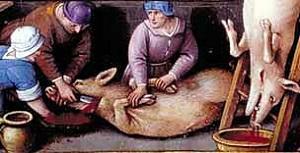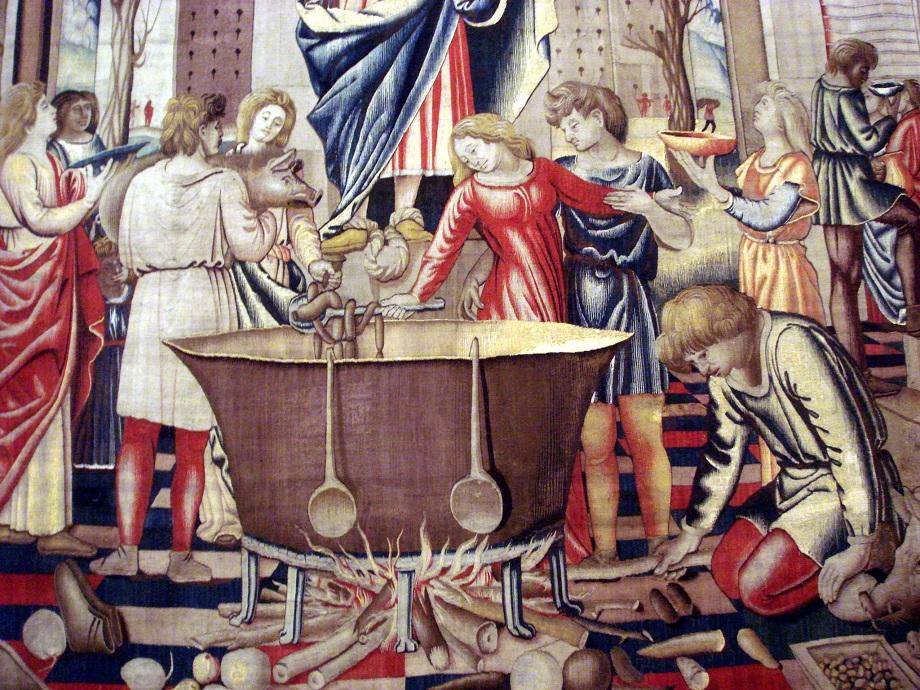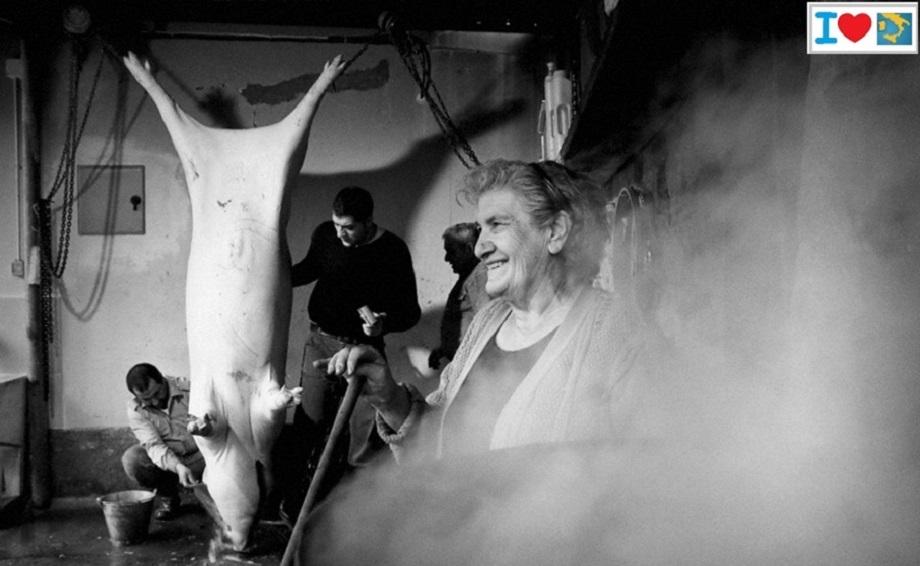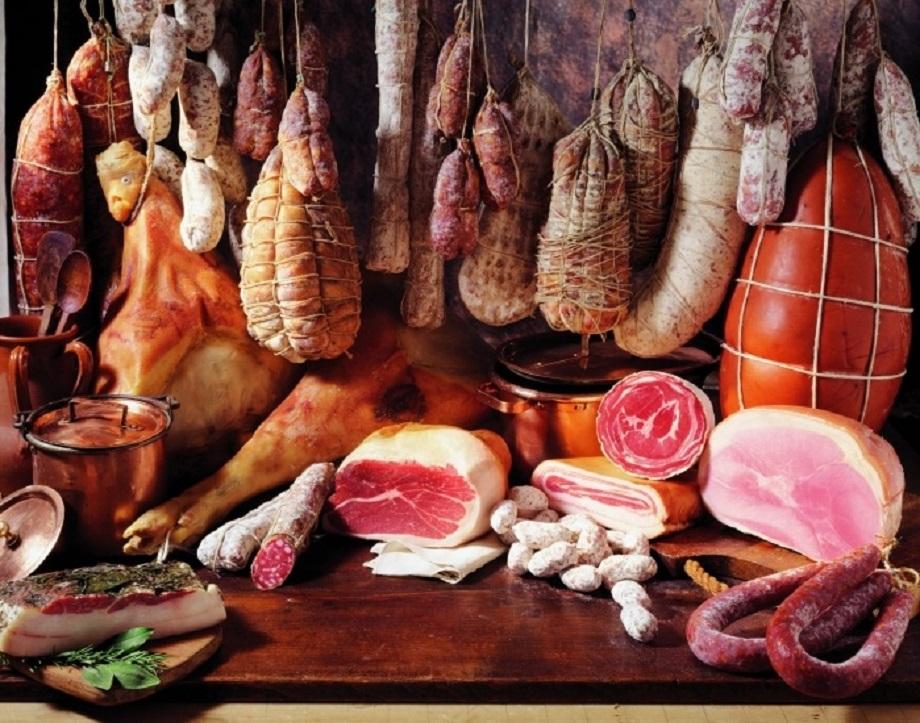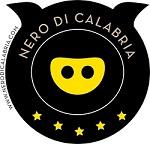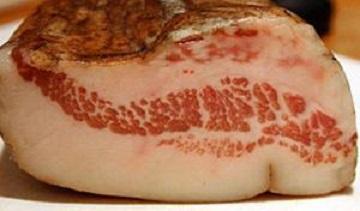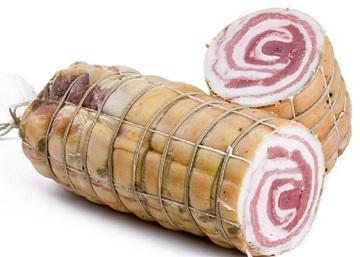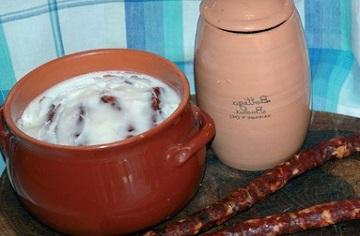|
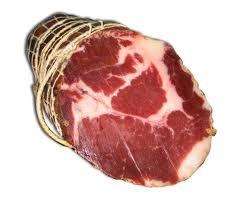
Capocollo - When cut, capocollo appears naturally pink, with thin veins of fat.
Its scent has the right intensity and the taste is strong and aromatic.
Capicollo, or “capocollo” is a packed product made of meat cut from the back of the pig’s neck from which it's named.
It's made of a single meat cut that is salted, spiced and then smoked.
Salting lasts 4 to 8 days. After that the capocollo is washed with water and bathed in vinegar.
Then it undergoes pressing, adding black peppercorns. Finally, it is wrapped in a pig's parietal diaphragm and tied up with a natural string.
The covering is pierced in order to facilitate dropping, which takes place in well airy rooms. Seasoning must occur in a place with controlled temperature and humidity for at least 100 days from the date of salting.
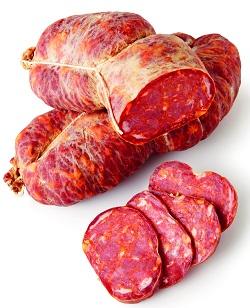 Soppressata - With the best part of pork, loins, the local people prepare one of the most well known Calabrese products: soppressata. Soppressata - With the best part of pork, loins, the local people prepare one of the most well known Calabrese products: soppressata.
Also called in local dialect soppressati, the term means "salted and pressed meat"; it has a cylindrical, slightly flattened shape.
The product's consistency is compact, more or less soft according to seasoning; its dark red color is due to the great quantity of hot pepper used, (as for the soppressata of Decolattura and Reventino); its aroma is very intense and the taste is spicy.
The shape of the Soppressata of Calabria recalls a cylindrical, slightly flattened shape.
The mixture is left to rest during the whole night before making it into sausages. It is then left to season for six months and, if not consumed, kept under a layer of fat in order to preserve them.
Cut into thin slices, it can be eaten in every moment of the day: as an appetizer, as a snack or to be served on special occasions.
The very same product in the regions of central Italy is called "coppa", while in Northern Italy what they call soppressata is a cured meat made from pig's tongue and parts of its head, salted, drugged and boiled.
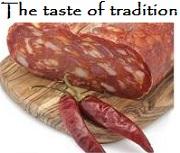 Schiacciata (pressed) is similar to the soppressata and is typical of the whole southern Italy. Schiacciata (pressed) is similar to the soppressata and is typical of the whole southern Italy.
Pork is selected and finely minced; it is added to bacon fat cut into small cubes, salt and hot pepper.
After that it is made into sausages using natural bowels and pressed so as to give it its typical flattened shape -whence its name, meaning precisely "flattened".
Soppressata Cilentana del Vallo di Diana e Gioi Cilento in the province of Salerno, and in the nearby towns, a very tasty smoked meat is produced.
It is typically produced only
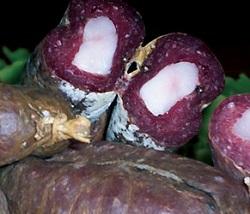
during winter, using lean pig first choice meat, hand cut and then seasoned with salt and pepper, and more rarely, with chili pepper and fennel seeds. The mixture is mixed several times to allow the ingredients to blend together, it is then left to rest a few minutes and then shaped with natural intestine.
The soppressata produced in Gioi Cilento, a specific town of the Cilento area, is characterised by a unique particularity: is it the only fat centered (lardellato) meat of Campania. In fact a filet of fat is inserted in the center the whole length of the meat from which the adjective “lardellato”.
The meat is aged about 40 days in well ventilated rooms; soppressata is then fumigated with wood son that the smoke can enhance its characteristic intense pig meat and spices aroma. The finished product is usually 8-10 cm of diameter and 15-18 cm long, it has a red-brown colour with a white heart and it can be preserved in olive oil or, rarely, in lard, to keep it fresh until the summer.
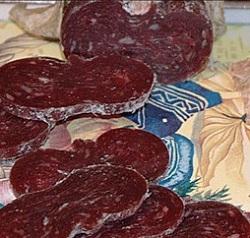
Soppressata del Sannio - In the whole province of Benevento
pig of various races such as Landrace, Large White, Pelatello and Casertana are raised on natural products such as corn, bran and acorns; it’s with the best parts of these pigs, such as the filet and the shoulders, that soppressata of Sannio is produced.
A tasty meat with a very ancient tradition.
To obtain it, the meats are cut in very small pieces, salted and seasoned with black pepper.
It is then hand mixed and left to rest for a few hours in bowls with holes to allow the water to trickle out.
The next phase is the shaping, this is a particularity also since it uses the largest intestine of the pig, washed and aromatized 24 hours in a solution of water, salt and citrus fruits skins before the use, and then hand filled with the mixture pressed in a cloth.
While the meat is shaped, small cubes of dorsal fat are inserted with to make the product softer and tastier.
At the end of the shaping, holes are pierced in the meat with a big pin and the meat is tied with cord like a net to press it more.
In the end it is hung from wood or cane structures and left to dry for about a month. The soppressata in then preserved whole in glass or ceramic recipients, totally covered with melted suet or in extra .
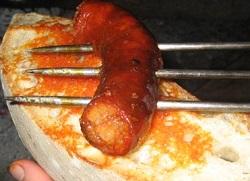
Sausages : Salsiccia or "sozizzi", their color is more or less red, according to the presence of red pepper on which its spicy taste depends.Their length can vary between six and seven centimeters.
They are prepare with shoulder meat without adding any fat. When cut it shows a middle grain with well distributed fat, its color natural red or bright red according to whether in the mixture black or red pepper was used. Its taste is sweet or spicy. Its scent is more or less intense, but natural. For the preparation of this product only pigs born and fed in Calabria can be used.
The sausage of Calabria is prepared with the well blended
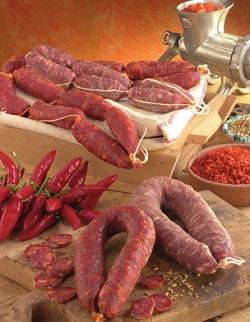
mixture of pig's shoulder and underside meats, with bacon fat and natural aromatic ingredients. Meats and bacon fat are worked when the room temperature is included bet. 0 and 3 degrees.
Lean meat and fat are blended slowly until obtaining a homogeneous product.
The mixture is then made into sausages using natural pig's bowels which are later on pierced and hand-braided into their characteristic chain shape and let rest for a few hours so as to allow the dropping of liquids.
Seasoning occurs in special rooms, for a period of at least 30 days. If fresh, they can be grilled or used as an ingredient in traditional dishes, while if seasoned they are ideal for small snacks.
Fiocco di prosciutto - In the province of Avellino, in the towns of Mugnano, Vallo di Lauro and Baiano, areas that have a great salami tradition, fiocco di prosciutto, also called culatello of Mugnano, is obtained from the leg of the pig.
It is a fumigated meat, with a shape that reminds of a pear; it’s small, between 10-15 cm of diameter and 15-20 cm long.
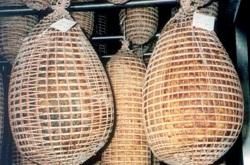 Fiocco di prosciutto is derived from the muscle around the tight bone of the back legs of the pig, and it undergoes a long and precise transformation: after being butchered, the leg is ripened and the muscle removed, salted and made into sausage-shape with natural intestine and tied up. Fiocco di prosciutto is derived from the muscle around the tight bone of the back legs of the pig, and it undergoes a long and precise transformation: after being butchered, the leg is ripened and the muscle removed, salted and made into sausage-shape with natural intestine and tied up.
The transformation proceeds with the pounding and drying that is performed in well-ventilated rooms; later, the meat is fumigated with oak or beech wood and left to age for about 40 days.
Fiocco di prosciutto is a high quality meat and its preparation is almost a ritual: the quality of its meats, the artisan work, the long ageing and the delight of its taste, all make it a “special” product, and it is usually eaten only on special occasions.
Prosciutto di Casaletto - Casaletto Spartano is a town in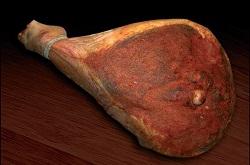
the province of Salerno famous for its production of a ham named after the town itself. Prosciutto di Casaletto is an exclusive product of Casaletto and surrounding towns, made from the butchering of specific races of pig, in particular the Large White or Landrace that are fed with the so called “giotta”, a feed made form residuals of human food and acorn. The ham is spiced with powdered chili pepper and salt and is aged for about a year.
The shape is classic, the weight varies between 10 and 15 kg, it has the typical dark pink colour. Traditionally Casaletto ham is offered during wedding party to the guests, cut in slices thick 5-6 mm, with caciocavallo and local wine.
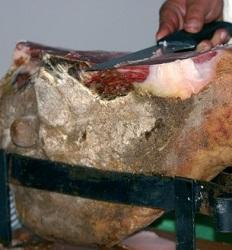
Prosciutto di Monte - In all the internal areas of the region, in particular in the Matese, Sannio, Irpinia and Bussento, a ham called “di Monte” is produced.
It is obtained from the excellent Large White or Landrace pig races and the “Casertano”, fed with natural forage like corn, bran, potatoes, acorns, chestnuts and other vegetables.
The butchering is performed between November and February or when the temperature reaches 10 C. The raw ham is obtained from the rear leg of the pig. The meat is salted, pressed and spiced. The ham is dried in the attics of the houses that are fresh and ventilated and that are covered with boards, to facilitate the natural circulation of the air and obtain the typical organoleptic characteristics of the product.
It is kept here until it is completely dried and then transferred to cellars.
During the whole drying phase the hams are covered with sacs made of thin cloth that allow the passage of air but not that of insects. Sometimes, just for a short time, a small quantity of smoke from the chimneys used to warm the living quarters, is allowed in the area and it helps improve the preserving qualities of the product and further characterize its taste.
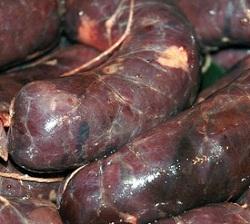 Samurchio : In ancient times, during the pig feast big fuming pots would appear at every street corner, to sell tasty samurchio, a meat obtained from boiled cow blood shaped with cow or pig intestines. Samurchio : In ancient times, during the pig feast big fuming pots would appear at every street corner, to sell tasty samurchio, a meat obtained from boiled cow blood shaped with cow or pig intestines.
Samurchio has a 2 hundred year old tradition in the province of Naples, and in particular in the areas of Calandrino, Sant’Antimo and Melito, but it has almost disappeared today.Like many ancient products, it was a recipe that was invented for economic reasons: it was used to exploit all the resources available from the animals, butchered for domestic use, by the poor population.
To this day the old preparation procedure is used, the cow blood is poured, using sifters recovered from the intestines of the cow and pig, spices with chili peppers and pepper, to flavour it and hide the unpleasant flavours that it has.
The sifting is performed to reduce to a minimum the coagulation and preserve the blood as long as possible before it is cooked.
The cooking is made in big copper saucepans, usually on fascine, wood residuals and it lasts about 20 minutes. Often, to mitigate the unpleasant odors due to the intestines, aromatic herbs amongst which bay leaves, are added to the boiling water.
Today the use of blood is a problem for the possibility of pathogeneses and dangerous microorganisms to develop, this problem is obviously resolved using tools and utensils that have been sterilized and also by boiling the blood.
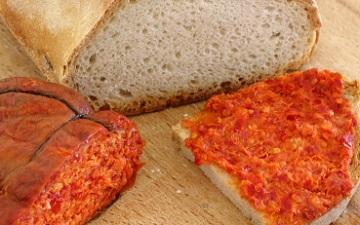
Nduja : Among typical products the 'nduja occupies a singular place in Calabrian gastronomy. To be spread on bread or to spice up simple dishes.
It is made from pork, small pieces of fat in moderate quantity, obtained from the under-stomach, from the shoulder, from the head, from the haunch and in any case not used for lard, sausages and soppressata, and later flavored with dried red pepper, sometimes in great quantity, so that it acquires a very spicy taste, much appreciated by gourmets looking for genuineness.
|
The 'Black of Calabria'
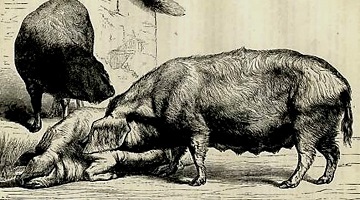
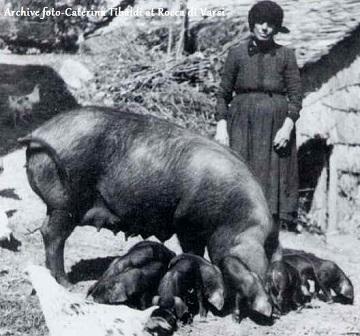
The meat of the black Calabrian pigs (Il nero di Calabria ) has been included with full rights in the list of traditional products issued by the Ministry of Farming Policies (the Italian Ministry of Agriculture, Fishery and Food).
The black Calabrian swine is bred in non-intensive way, in wide spaces in the open air where it can root completely freely.
Such kind of breeding allows to exploit the huge productive potential of the fringe areas and woodland of hilly and mountainous districts as well as the reclamation of rural areas otherwise destined to remain untended.
From meat treatment several high-quality products with genuine taste are obtained, such as soppressata, capicollo, sausage and bacon.
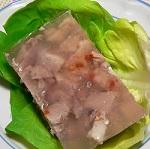 Pork Jelly (gelatina di maiale): Made up of small pieces of pork, pork rinds, pork chops, pork paw and ear, with the addition of wine vinegar and lemon juice, red pepper, laurel leaves, pine-seeds and grapes. Pork Jelly (gelatina di maiale): Made up of small pieces of pork, pork rinds, pork chops, pork paw and ear, with the addition of wine vinegar and lemon juice, red pepper, laurel leaves, pine-seeds and grapes.
Guanciale : This specialty of un-smoked lard is obtained from the pork's "cheek/jowl/ ".
Similar to bacon as for its composition, since it is made up of adipose tissue with one or two transversal veins of lean muscle, however it consists of a cut obtained from the pig's cheek and part of the neck.
It is slightly different from that of bacon and its consistence is hard. The extra fat gives it a sweeter taste and is mostly used to add on pasta dishes, since its taste is less overpowering then the smoked bacon/pancetta.
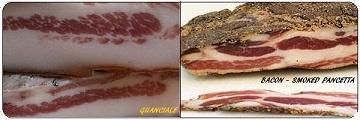
From the pork belly comes the Bacon also known as Pancetta .
As for all cured meats, its production derives from the ancient need to preserve and to spread consumption over a longer period of time.
Salt in this case, is used as preservative, spices, such as black or hot pepper is uses for its with antiseptic properties in order to prevent , to oppose the forming of molds. After preparation it undergoes salting process for a period of 4 to 8 days.
Later on it is washed with water and moistened with vinegar and wine.
The superficial part can be again covered with hot pepper.
Then follows a period of seasoning for at least 30 days.
Pancetta adds a distinctive pork flavor to pasta and other dishes, without infusing into them bacon's smokiness and its an ideal an appetizer.
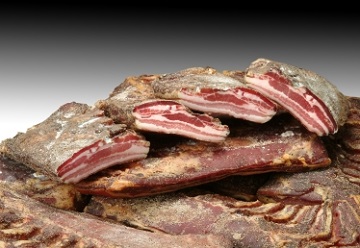
Pancetta tesa is a smoked salame produced in the whole region and in particular in the areas of Matese, Sannio, Irpinia, Nolano, Vallo di Diano and Cilento. It is produced using the ventral zone of the pig, alternating more or less thin layers of fat and lean parts. The most common pancetta tesa is the square one with or without pigskin. It has a white pink colour that goes to dark red and it’s characterized by a decisive and slightly aromatic flavour.
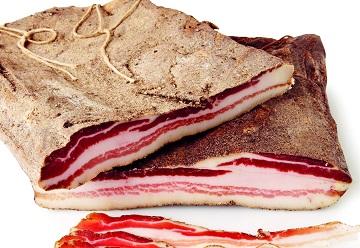
Pancetta - Outside of Italy, pancetta most often comes rolled (rotolata) so that the fat and muscle spiral around each other. As the name implies , pancetta (pancia- belly) comes from the pig's ventral area from which it is obtained. Rectangular and red due to the presence of hot pepper, its taste is delicate and sharp. It can be rolled up or left stretched and its weight varies between. 3 and 4 kg. Its scent is intense and natural.
Rolled pancetta is normally cut into circular paper-thin slices before being fried, while slab pancetta is usually chopped or diced before being added to a dish. In North America t's a common substitute for guanciale, which is the cured pork cheek that is the traditional base for many classic pastas, like carbonara or all'amatriciana.
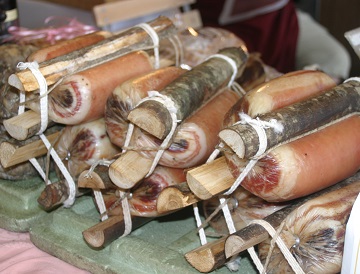
Nnoglia or doglia of the pig is a typical salami like meat of the territory around Bagnoli Irpino, in the province of Avellino, and like many typical meats of this region it’s obtained from the leftovers of the pig. To obtain the nnoglia the big and thick parts of the stomach and the intestine of the pig are used after being pressed, fumigated and aged for 20-30 days.
The parts of the pig are washed and left in the water with orange and mandarin peels for a few days, after they are washed, dried and mixed with salt, chili powder and wild fennel seeds, letting it marinade for ten days. Once it has rested, it is made into a salami in the biggest intestine, and then left to dry in a well ventilated and fresh place.
It is characterized by a decisive and chili flavour, nnoglia is used to prepare the traditional married soup (minestra maritata) and, at Easter, to prepare wild chicory soup.
The lard was used by poor populations as a fat reserve in order to face out cold and hard work.
Rectangular and red due to the presence of hot pepper, its taste is delicate and sharp.
Salsiccia sotto sugna di Varano - The most authentic tradition requires the sauciccia to be preserved in suet in varnished terracotta vases, still manufactured by artisans that are active in Cascano, near Sessa Aurunca, and in Calvi Risorta.
|
|

